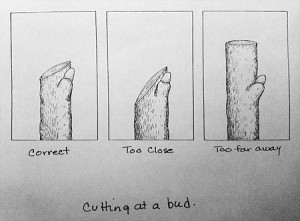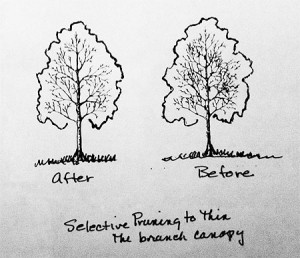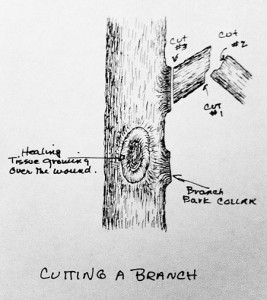
A
good pruning job on any type of tree is like a good haircut. You cannot tell that it has been done. It is not that difficult to accomplish this. Once you become familiar with a few basic guidelines, you will gain confidence and may find that you actually enjoy this job.
- Over pruning may kill a tree. Be sure that at least 2/3rds of the live tree remains after a pruning session.
- When cutting dead ends of branches, always make the cut back where healthy wood exists.
- When pruning off the end of a healthy branch, always make the cut back to a side branch where another branch intersects or where a swollen bud for new growth is starting.
- A proper pruning cut at a bud should be 1/8 to 3/8 inches above the bud swelling. Angle pruner blades parallel to the direction the bud is pointing.
- When pruning off part of an outside branch, always leave an outside bud.
- When cutting a tree limb from the main trunk, do not cut the branch flush with the main stem or trunk surface. This opens a wound on the protective bark on the trunk which does not have tissue that can grow over and heal the wound. Instead, align the cut with the distinctive ridge of bark where bark tissue from the branch merges into bark tissue of the trunk at the base of each branch. Called the “branch bark collar,” this seam makes a bulge that must remain after pruning to insure that healing tissue there can grow over and heal the wound. Remember, larger wounds from cutting large branches take longer to heal because of their size and the age of the tree.
- When cutting a large branch, make several preliminary cuts before actually severing the branch from the tree. This will reduce the weight of the branch so that when it is finally cut at the branch bark collar it will not strip bark from the trunk.
- When pruning smaller branches, shoots, or twigs, do not leave visible stubs. Not only are they unsightly, but they also provide access by diseases and pests into the tree.
 Never, never “head back” or stub the ends of tree branches, or top a tree by bluntly cutting the top of its main stem or trunk off . Do not allow any arborist or landscaper do this to your tree to control its size. Not only will it fail to control its size, (because new branches will grow back to the same length the tree species is programmed to mature to), it will also shorten the tree’s life span by stressing it, weakening it and making vulnerable to disease, pests and storm damage. Of course it will lose its natural beauty and value to your landscape as well.
Never, never “head back” or stub the ends of tree branches, or top a tree by bluntly cutting the top of its main stem or trunk off . Do not allow any arborist or landscaper do this to your tree to control its size. Not only will it fail to control its size, (because new branches will grow back to the same length the tree species is programmed to mature to), it will also shorten the tree’s life span by stressing it, weakening it and making vulnerable to disease, pests and storm damage. Of course it will lose its natural beauty and value to your landscape as well.


